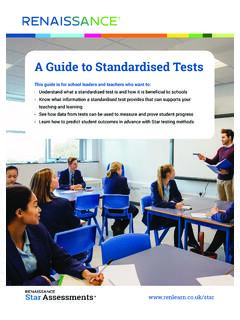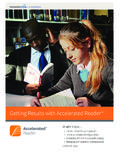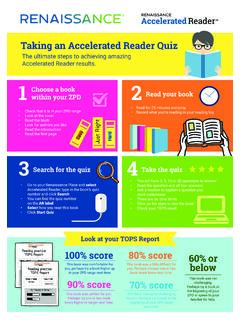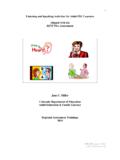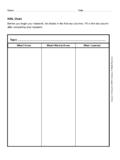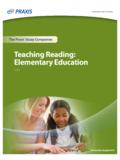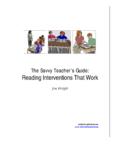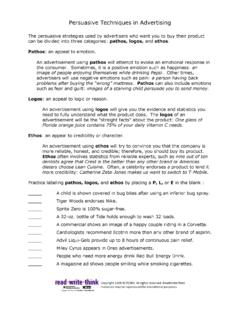Transcription of ACCELERATED READER IMPROVING COMPREHENSION …
1 ACCELERATED READER IMPROVING COMPREHENSION BOOKLET 2 Contents: Page: 1. What Makes a Proficient READER Links with AR Supporting Resources 3 2. RSP Symposium Presentation Top 10 Reading Strategies With Resources 10 3. DEAR Time Resources and Generic Activities 25 4. Non-Fiction Resources 44 5. Posters and Bookmarks 58 6. Teacher Monitoring Resources 67 7. References and Further Reading Links 79 3 Section 1. What Makes a Proficient READER ? Links with ACCELERATED READER Supporting Resources 4 * What Makes a Proficient READER ? Proficient readers successfully leave tracks of their thinking when actively reading a text. _____ * A summary on the key points of these strategies follows. For detailed information on the strategies, please refer to COMPREHENSION Strategies Defined at the end of this booklet within the Teacher Monitoring section.
2 1. CONNECT TO THE TEXT 2. ASK QUESTIONS 3. EXPAND VOCABULARY 4. PREDICT AND PROVE 5. SENSE IT 6. DECIDE WHAT S IMPORTANT 7. MAKE INFERENCES AND DRAW CONCLUSIONS 8. SUMMARISE AND SYNTHESISE 9. CHECK UNDERSTANDING 10. BUILD FLUENCY 5 Proficient Readers Are Able Links With AR Supporting Resources 1. CONNECT TO THE TEXT Key Points: Recall prior knowledge, before, during and after read. Use text to self, text to text, text to world connections. Learn new things. Knowledge changes and adapts. Information is learned, remembered and reapplied. Explain their use of knowledge. Engage in discussion about this with others. Use their knowledge of techniques in the authors craft. Make connections with how they read and their own preferences. Each type of background knowledge permits students to monitor for meaning, pose questions, make predictions, draw conclusions, create mental images, synthesise, and determine importance as they read and learn.
3 Teachers help build background knowledge and remind students on using it. Connections with the text increase as the volume of reading increases with AR. When students are guided to read at the right AR Book Level of difficulty and can read with success on AR quizzes, this motivates more reading and can nurture an intrinsic love of reading. Texts then become more memorable, increasing knowledge and enabling more connections. AR engages students in literature based reading and encourages them to choose from a huge variety of reading material from different genres within their ZPD, developing knowledge of all different text types. There are currently over 4,500 AR quizzes on Non Fiction books to help challenge and expand students background knowledge on various topics. Literacy Skills Quizzes focus on Literary Analysis and these contain specific questions to analyse the authors craft and understand historical/cultural factors. The Pupil Record Report and Home Connect display details of all books read and quizzed on.
4 Students can then reflect on their preferences for reading and connections between their book choices. Making Connections Chart what the text is about, what it reminds me of. p15 Making Connections Self, Text, World - filling in the phrase/situation from the text and my connection. p16 Thinking about Connections to record thoughts whilst reading. p21 Coding the Text post-it-notes with T-S, T-T, T-W connections. p34-35 Inference Record Form - When I read__I think__because (my background knowledge). p14 Thinking Spot on pivotal plot notes writing down connections, predictions, questions and feelings. p43 Nonfiction Conventions Notebook to record examples of features in the text and build background knowledge. p46-57 Make a Mini Booklet . p33 Thinkmarks to make a connection and use background knowledge. p64 2. ASK QUESTIONS Key Points: Ask spontaneous, purposeful questions before, during and after reading.
5 Give rhetorical questions inspired by text. Questions may be to clarify meaning, be critical, speculate what will happen next, find an answer in the text or to consider why the author is writing that way. Understand many questions answered are the READER s interpretation. Know if it can be answered in the text, inferred from the text or by other text/background knowledge. Know why questions are important in all areas of their lives and how it deepens understanding. Know how one question leads to another; listening to other questions and generating own. Use background knowledge and text to answer their own questions, make connections. AR boosts confidence in reading and students then feel more able to ask questions. Reading Practice Quizzes familiarise students to think about key questions on every book they read. Self-generation of these questions and further questions can often come more easily to the student. Literacy Skills Quizzes provide questions on higher order thinking skills, with three quizzes on each book.
6 This gives students experience of a wide range of in-depth questions that can be generated. The Four-Door Chart to fill in; Predict, Question, Clarify and Summarise. p32 Make a Mini Booklet . p33 Coding the Text post-it-notes with? for I wonder, then write out your question. p34-35 Asking Questions before, during and after reading with possible answers to complete. p18 Thinking Spot on pivotal plot notes writing down connections, predictions, questions and feelings. p43 Thinkmarks to ask questions. p63-64 Asking Questions with quote from the text, question and possible answer. p17 6 Proficient Readers Are Able Links With AR Supporting Resources 3. EXPAND VOCABULARY Key Points: Use their oral vocabulary to make sense of the words read. Know how to check meaning of unknown words. Use typographical, structural analysis of words and contextual clues to understand and infer new vocabulary. Apply newly learned words in their writing and oral vocabulary.
7 Can share their prior experiences with the words used. Word knowledge is developed by repeating the words in a variety of contexts. Draw on their connections, use imagery and prior knowledge to find word meanings. AR guides students to read within a ZPD to accelerate reading growth. Students can see their potential for reading challenge. Vocabulary is therefore built upon with reading more challenging levelled text. Reading Practice Quizzes develop skills of identifying and reading words and recalling word meaning. Vocabulary Quizzes help students acquire and learn new vocabulary within the context of reading material. Correct definitions are identified, helping develop students precision in word choice. Vocabulary Quiz questions have second-try and review words to help build and check vocabulary knowledge. TOPS Reports for Vocabulary Quizzes and Home Connect provide feedback on words learned and words to practice, therefore encouraging revision for missed words to achieve mastery.
8 Literacy Skills Quizzes include questions on deriving word or phrase meaning. 5 Finger Rule Cue Card to help choose appropriate books with vocabulary suitable for my understanding. p62 Thinkmarks to write down words which help you visualise. p64 Strategies for Expanding Vocabulary Resource. p23-24 Make a Mini Booklet . p33 Coding the Text post-it-notes with ? for new words that puzzle me, then find out what these words mean. p34-35 Using Context Clues p36-37 Games that Aid Vocabulary Acquisition p38 Vocabulary Acquisition Worksheet p39-40 4. PREDICT AND PROVE Key Points: Anticipate what is coming next and change predictions whilst reading. Adapt conclusions as a result of reading further into the text. When readers predict they are aware when meaning is breaking down. Check if predictions were correct, referring to examples in the text. Explain why they arrived at those predictions and why this has changed. Use prior knowledge to support reasons for predictions.
9 When an event doesn t match a prediction good readers rethink and revise their thinking. Literacy Skills Quizzes have Inferential COMPREHENSION questions which include making predictions and drawing conclusions. The Four-Door Chart to fill in; Predict, Question, Clarify and Summarise. p32 Make a Mini Booklet . p33 Thinking Spot on pivotal plot notes writing down connections, predictions, questions and feelings. p43 Multiple Entry Journals to record predictions about what will happen based on your reading. p30 Thinkmarks to make a prediction. p64 Coding the Text post-it-notes with P for predict and for confirms what I thought or X for I thought differently. p34-35 7 Proficient Readers Are Able Links With AR Supporting Resources 5. SENSE IT Key Points: Make spontaneous and purposeful images during and after reading, using all five senses. Use senses to gather detail which immerses them in what they are reading. Engagement and COMPREHENSION are heightened and the text is much more memorable.
10 Emotions are anchored in readers prior knowledge and personal experience. Images are used for recall and drawing conclusions. Use these images in their writing. Images adapt as they read more and are adapted after sharing images with others. Explain how images help their COMPREHENSION . AR monitors engaged time, which will be high if students are immersed in reading. Literacy Skills Quizzes have Initial Understanding questions, prompting students to draw on senses to analyse characters feelings and extract details from the text. Coding the Text post-it-notes with V for visualise or make a picture in my head. p34-35 Say, Mean, Matter Chart . p31 Story Wheel with drawings of thoughts about each aspect of the text. p42 Thinking Spot on pivotal plot notes writing down connections, predictions, questions and feelings. p43 Make a Mini Booklet . p33 Thinkmarks to help you visualise. p64 Visualising sheet with thoughts of what I can see, hear, smell, taste, feel in aspects of the text.

